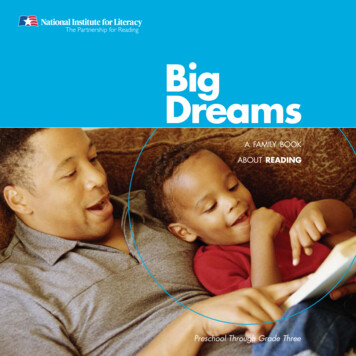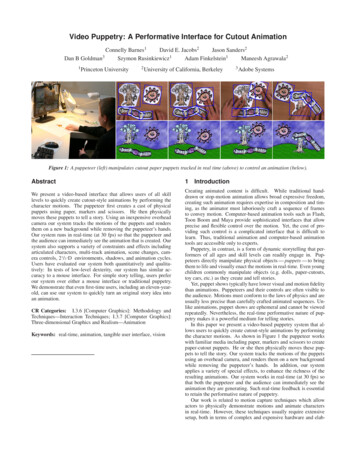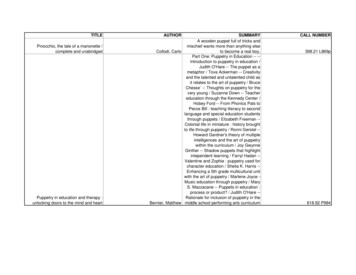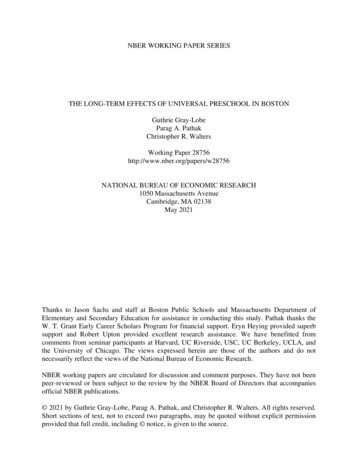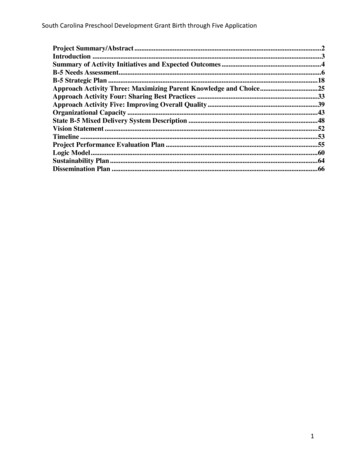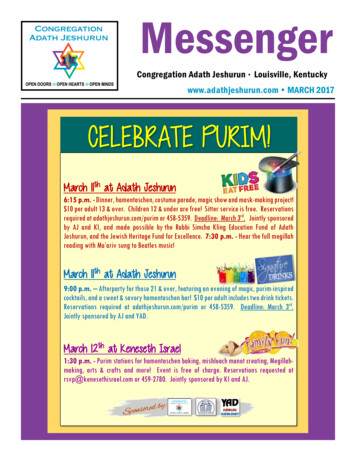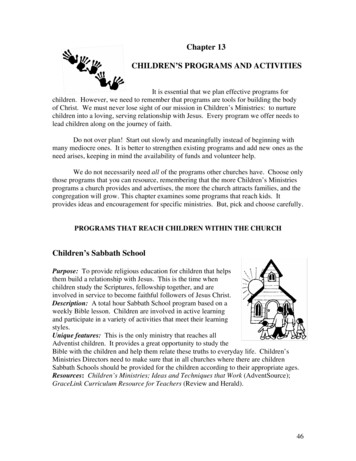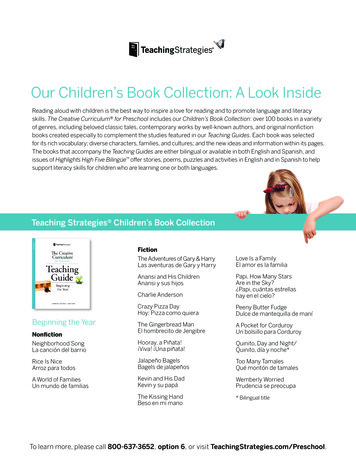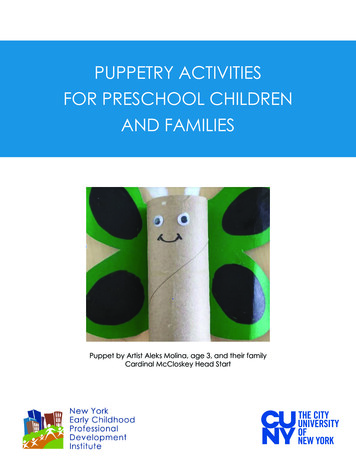
Transcription
PUPPETRY ACTIVITIESFOR PRESCHOOL CHILDRENAND FAMILIESPuppet by Artist Aleks Molina, age 3, and their familyCardinal McCloskey Head Start
INTRODUCTIONThis document is a curriculum planning resource for educators, created by the New YorkEarly Childhood Professional Development Institute’s team of early childhood coaches.It can be used in classroom, home-based, distance-learning, or family engagementgroup settings.Puppet making can be an open exploration of creativity and play-based imagination.It offers a fun way for children and adults to interact, connect with stories, and exploretheir own and story characters’ relationships. Children can use any material availableto them and children and adults can make anything they want – their only limitation istheir imaginations.We look forward to hearing how you use this resource and your feedback. You cancontact us directly at questions@earlychildhoodny.org.ACTIVITY 1Children and caregivers create a puppet.Books Stories that feature interesting characters in relationships include:Sheila Ray, The Brave by Kevin Henkes : Sheila Ray is a mouse who believes herself tobe fearless and teases her younger sister for being afraid. In the end, her younger sisterrescues her when she is lost in the woods. As a result, their relationship changes.Read Aloud Video: https://www.youtube.com/watch?v wsFtGHsyZCUMonster Mama by Liz Rosenberg : Patrick Edward’s mother is a monster. When bulliesattack him, he and his mother deal with them together to turn a bad situation around.Read Aloud Video: https://www.youtube.com/watch?v p7MiVfV4sGcAbuela by Arthur Dorros: A child and her grandmother have an imaginary adventureflying about their city.Read Aloud Video: https://www.youtube.com/watch?v Bl3GIsyS66gPossible Materials: crayons, markers, paper, fabric, cardboard, felt, foam, paper bagsor plates, socks, sticks, straws, twist ties, boxes, recycled caps or lids, scissors, glue, tape,tissue paper, magazines, wrapping paper, or other household items.THINKINGAs children make puppets, they explore different ways of being and interacting aspuppets. Their characters come from their ideas and experiences, and sharing thesehelps children to understand who they are and how to relate with others. A puppetoffers a vehicle through which to explore feelings in social interactions. Creatingpuppets unleashes their imagination through hands-on explorations of materials, artmaking, and storytelling. This process promotes early literacy as they start to dream upadventures for puppets to embark upon. Children are guided to describe details (e.g.how their puppets look, their decision-making, who their characters are, and what theysay). NY Early Childhood Professional Development Institute2
INTRODUCTIONHave your puppet introduce itself, ask children questions, and respond to children’squestions. Then ask children what happened object (foam square, sock, or bag). Discusshow this transformed into a puppet. Tell children they are going to make their ownpuppets to play with and talk to each other.CREATIVITY TIMEBegin work with materials for making a puppet. Hook children into discussion naming shapes to use for different parts. As children name shapes, use pre-cut shapes(square, circle, triangle, rectangle) to make body parts and place them onto a paperbackground. Talk about more ways of making puppets asking for suggestions for whatmaterials to put together. Think aloud by talking about your decisions (use of lines,shapes, colors, to make forms). Show how to create details, for example, to make apuppet’s eyes, mouth with different expressions, or hair.REFLECTIONDuring a reflection, children take turns sharing with the group or family member. Youmay prompt them by asking what kinds of lines (jagged, delicate, sharp), colors (bright,soft and dark), and shapes they chose to put together to make forms, and why theymade those visual decisions for their creations. Children may begin to personify theirpuppets. Direct open-ended questions to puppets, “Tell me about yourself.” Allowchildren to express thoughts with their puppets’ movements, gestures, and words. Youmay guide children by asking “How are they related to one other?” Observe children’sinteractions with puppets and document with photos and videos. Families and teachersmay encourage children to extend their play and continue sharing their observations. NY Early Childhood Professional Development Institute33
ACTIVITY 2Children explore creation of animal, insect, or imaginary character puppets withmoveable parts.Books Foster ideas for creating animals, insects, or imaginary character with whimsicalstories including:The Very Hungry Caterpillar by Eric Carle: This is a story about a hungry caterpillarlearning about eating well, staying inside, and transforming into a butterfly.Read Aloud Video: https://youtu.be/vkYmvxP0AJIAs Quick as a Cricket by Audrey Wood: This story invites thinking about animals andinsects. You can help children make connections with their experience with animals andinsects and begin to imagine their own creatures.Read Aloud Video: https://www.youtube.com/watch?v XuIJvFkg ZMAmos and Boris by William Steig: This is a tale of adventure and friendship between twocharacters, a whale and a mouse. They meet in an unusual situation and form a deepfriendship.Read Aloud Video: https://www.youtube.com/watch?v 0hE3W4PCdxIPossible Materials: cardboard, folders, cards, scissors, pipe-cleaners, twist ties, paper,sticks, straws, plastic spoons, yarn, feathers, buttons, plastic caps, foam trays, maskingtape, glue, craft sticks, hole puncherTHINKINGYoung children imagine themselves to be a character that is an animal/insect/imaginarycharacter. It may be easier for a child to express their feelings and thoughts throughpretend play. Brainstorming a list of animals they know and the physical characteristicsof each creature together will support their thinking. Then let them know they will havea chance to make characters, such as animal puppets, that move and talk.INTRODUCTIONYou may ask if they remember their puppets or you can prompt children to recollectdetails about how they made them. Brainstorm to create a list of possible characters.You may model using a brainstorm on animals that live in oceans, on a farm, in thecity, or in a forest. Another way to start discussion is using a read-aloud to discusscharacters. Allow each child to take a turn to share connections. Encourage childrento think about characters and their body parts first and then add details to their form.Use open-ended questions, such as: “What shapes form a lion’s body?” Focus on abody part, such as the head “What shape is its head?” “How do you think a lion’s manewould feel?” Invite children to close their eyes and imagine themselves to be a particularcharacter and what this character likes to do. Is it friendly or not? What kinds of thingsare important to it? Open eyes on the count of three and get to work making it. NY Early Childhood Professional Development Institute4
CREATIVITY TIMEChildren begin by finding materials to put together to form a character. Try placingshapes onto a background sheet of paper. Make a face to put on an object. It may notbe easy, and remind them that they may ask for help. Adults can also ask what theywould like help with and assist to make the characters. Ask children to find materials toadd details, such as facial features and hair. Open-ended questions help them envision:“What kind of teeth do crocodiles have?” “What do they do with their teeth?” “Howdoes a rabbit’s tail feel?” Encourage children to move puppets and have them talk ormove.REFLECTIONInvite children to share their puppet making experiences and to talk about decisionsand why they made them: “I can see that you glued shiny paper onto your monkey’sclaws. Why did you do that?” or “The tail of your cat is standing up high and looksexcited. Can you move it down to touch the ground? What do you think she is thinkingabout now?” Children may also make characters talk. This usually happens withoutprompting. You may initiate this by asking puppets questions: “I can see you have abright yellow beak. What sort of things do you like to eat with your beak?” or “You havea long body with three parts, and you are standing upright with your six arms and legsbent. Are you dancing?” or “Cat, you look like you are smiling and pleased with yourself.Why are you so happy?” Children may continue to create and play with puppets. NY Early Childhood Professional Development Institute55
ACTIVITY 3Children explore creation of animal, insect, or imaginary character puppets withmoveable parts. Children may create an environment for their puppet characters.Books. To inspire ideas about animal homes and habitats share stories such as:A House is a House for Me by Mary Ann Hoberman, illustrated by Betty Fraser: Thisimaginative story relates to where people and things feel most comfortable.Read Aloud Video: https://www.youtube.com/watch?v s4cGB0-7R-0Call Me Tree/Llamame Arbol by Maya Christina Gonzalez: The child finds a way to growfrom the inside out, just like a tree, comfortable in the natural world and in relationshipswith others.Read Aloud Video: https://www.youtube.com/watch?v sA6daOKHu UWhere Once There Was a Wood by Denise Flemming: Collage illustrations of acountryside setting show animals and birds living freely. The story concludes with theimage of rows of houses “where once there was a wood.”Read Aloud Video: https://www.youtube.com/watch?v KiwhoZa5cX8Possible Materials: Paper, cardboard, crayons, markers, or paintTHINKINGChildren can explore storytelling with their characters in particular places. Children willuse visual details to create an environment for their puppets. They will continue to makedecisions to create with lines, colors, and shape. Children will use puppets in pretendplay to create dialogue and events in places where animals live.INTRODUCTIONBegin with the question: “Where does your character live?” This gives children a focuson envisioning where the character makes a home. “Francisco said that his hamster livesin a nest. What is that nest made out of? Do you imagine your hamster sleeping thereduring the day or at night time?” Share ideas about places and possible materials touse, such as crayons, pencils, or markers. Model drawing with a crayon or marker how tocreate a background. Brainstorm how they may create a daytime or nighttime scene.CREATIVITY TIMEFLECTIONDuring this time, children may work alone or with someone and may use puppets. Anadult can ask about their ideas in open-ended ways, such as: “I can see you have useda lot of brown in your picture. Tell me about that place.” or “Does your character likehot weather or cold weather?” As the children work, they can play with puppets andinteract with each other to stimulate ideas. NY Early Childhood Professional Development Institute6
REFLECTIONInvite children to share their drawings of places and how or why they created them.They can have puppets talk about their homes. Children can talk about any issues theyhad and how or what they tried. You can guide discussion of decisions they madeasking: “I see different colors of green in your picture. It looks like a bright, sunny day.”“Does your character live in a place where it rains a lot?” or “Tell me more about thatplace.” At the end, share how they could continue to play with a stage: a cardboard boxwith a rectangular hole where a picture could be placed to make a background. Childrenmay create a stage using a table or holding a puppet over drawings.ReferencesCurriculum adapted from: Studio in a School. (2008). Puppetry Workshops, EarlyChildhood Curriculum. New York, NY: Studio in a School. NY Early Childhood Professional Development Institute77
Puppet making can be an open exploration of creativity and play-based imagination. It offers a fun way for children and adults to interact, connect with stories, and explore their own and story characters’ relationships. Children can use any material available to them and childre
